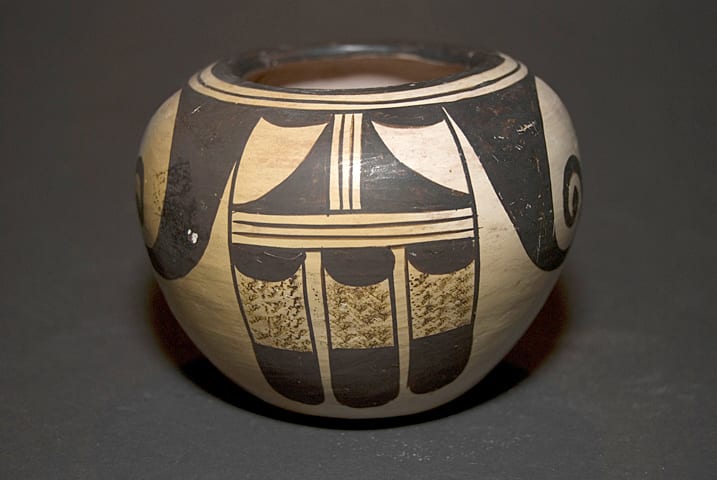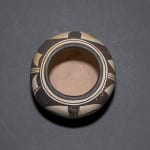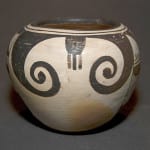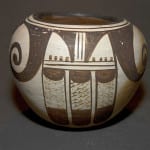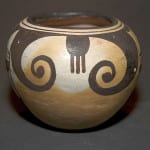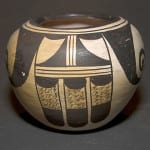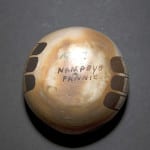This jar is signed “Nampeyo/Fannie” and marked “1942” in pen. Apparently, Nampeyo formed it and her daughter Fannie painted it.
Nampeyo probably began potting when she was a teenager in the 1870s; her Sikyatki Revival style dates from the early 1880s. Her eldest daughter, Annie, began helping her mother form pottery and paint in the 1890s, when she was a teenager. After Nampeyo became functionally blind (1916-1920), her female relatives painted their mother’s pots. While the literature has assumed that Fannie was the person who painted her mother’s pots once Nampeyo was blind, Appendix E presents evidence that middle daughter Nellie also painted for her mother, as did granddaughters Daisy, Rachael and Beatrice.
Jar 2007-12, however, was unambiguously painted by Fannie. A 1980 exhibit catalog quotes Fannie as saying: “I helped my mother –I lived there—and my father who polished. When mother’s eyes were no good I helped to paint. I made my own when I was 25 [about 1929], before she died (ACA Galleries, 1980:17.”
While Fannie certainly became a master potter in her own right, her version of the family “eagle-tail” design is more static than her mother’s; Fannie’s incurved wings are bold and thick, which emphasizes the design element. In contrast, the overall design of Nampeyo’s eagle-tail jar (see 2005-16) is full of tension and energy; her incurved elements are light and float around the incorporated background space. (For a discussion of the difference in treatment of the eagle tail element by Fannie and her mother, see the catalog entry fort 2005-16 .) Monochromatic and small, jar 2007-12 was never intended to demonstrate Fannie’s range of ability as a painter. Nevertheless, other eagle-tail pots by Fannie display a similar painting style. For example, see a very similar pot in this collection both formed and painted by Fannie (2009-01).
In their tile book, Kim and Pat Messier publish a photograph of Nampeyo holding an eagle-tail jar. Her white hair and the cast of her eyes date the photograph to the 1930s—well after Nampeyo had lost her eyesight and was no longer painting . The eagle-tail feathers shown are typical of the daughter’s heavier rendition. Hitchcock and Stanislawski provide the first systematic study of identification marks and signatures on Hopi-Tewa and Hopi pots. They write that “Pots signed ‘Nampeyo-Fannie were probably molded by Nampeyo and painted by Fannie, and date between 1932 and Nampeyo’s death in 1942. Pottery signed “Fannie Nampeyo” was made by Fannie alone, after 1942 (1976:52).”
Barbara Kramer cites a slightly earlier date of the used of the Nampeyo/Fannie signature. Pots with the signature “Nampeyo,” she writes, “were formed after 1930 by the Old Lady and painted by a daughter (Kramer,1996:134, 158).”
It is probable that Fannie painted and signed most of these pots, first simply marking the pot with her mother’s famous name “Nampeyo.” Later in their collaboration, Fannie began adding her name; she placed her mother’s name first and her name second, as on pot 2007-12. When Fannie both formed the pottery and painted it, she signed her work “Fannie Nampeyo,” as on pots 2001-07 and 2009-01, which were probably made about the same time she painted 2007-12. (For a discussion of the sequencing of signatures, see the Blairs,1999: 213-214.) The collection now contains three pots—1985-01, 1997-01, and 2002-07—that were presumably formed by Nampeyo and simply signed “Nampeyo” by whichever daughter (most likely Fannie) did the painting Four pots in the collection—1996-05, 1997-04, 2002-09 and 2006-01—are unsigned but were likely formed by Nampeyo and painted by Annie. Pot 2003-07 is signed “Nampeyo/N,” and was presumably formed by Nampeyo and painted by Nellie. In short, some of the pots formed by Nampeyo and painted by her daughters after 1930 were signed with various signatures. Of the signatures used, jar 2007-12 completes the set of known permutations.
Pot 2007-12 thus represents both the end of Nampeyo’s 60+ years of pottery making and almost 50 years of partnership with her daughters. The date 1942 inked on the bottom marks the end of the lifetime and career of perhaps the best and certainly the most historically important Native American potter.
For other pots in the collection by Fannie, see the Artist List.

